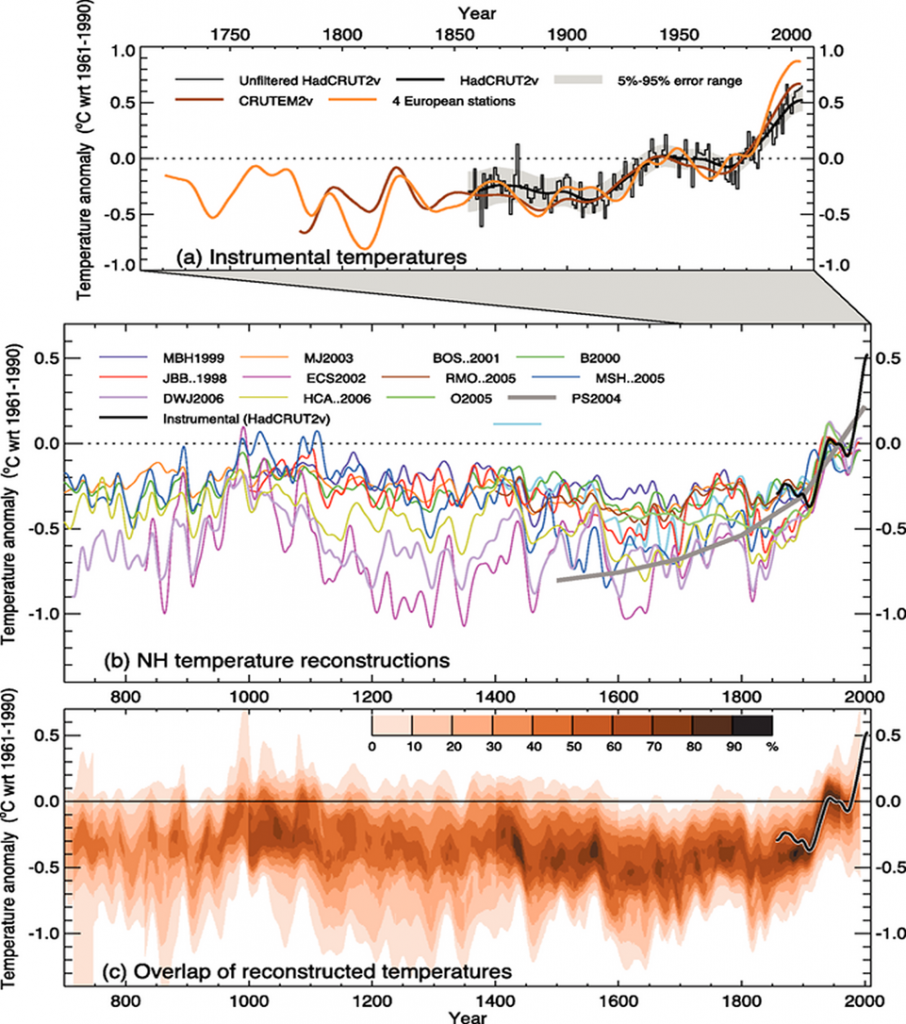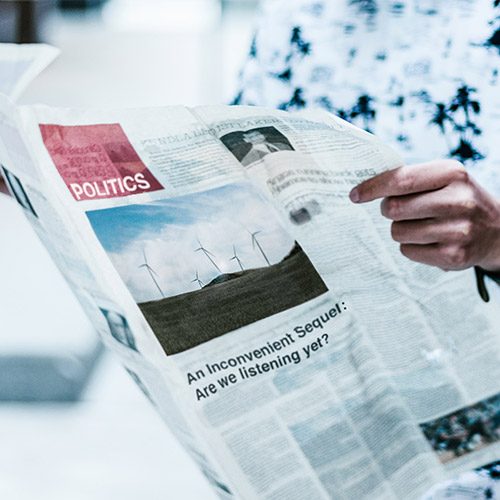Stop climate change. Part 2 final
A slap on the face.
Recent climate change is not counted from the 1950s when we first realized its importance. It is happening for a much longer period. Scientists are sure and data proves it – the major climatic changes started with the industrial revolution in the 1760s.

The first Earth Day. 22.04.1970, New York.
How can we assess climate change in a long-term period? The most powerful tools we have are temperature and concentration of different gas records: from proxy data, which is the information from the ice and trees to modern ways of measuring it.

Northern Hemisphere Surface Air Panel (a) – Northern Hemisphere surface air temperature data from the modern instrument era from various sources. Panel (b) – Northern Hemisphere surface air temperature reconstruction dating back 1300 years from various sources. Panel (c) – Percent of overlap between the various sources of Panel (b). Source: Climate Change 2007: The Physical Science Basis: Contribution of Working Group I to the Fourth Assessment Report of the Intergovernmental Panel on Climate Change, Cambridge University Press
The table shows temperature records over the last 1300 years. It is clear, the variance between maximum and minimum temperatures rarely exceeded 0.5oC. And now we are at the point of +1.1oC on average, compared to the pre-industrial temperatures.
You probably remember from the previous post, climate changes under certain conditions. Those are alternations to insolation, albedo, and composition of the atmosphere.
Can the Sun for some reason give us more energy now than it was before? No. The average variation of the solar energy input is less than 0.1% in 11 years (a period for the Sun to finish its cycle). And it’s not even nearly enough to warm our planer up to 1.1oC.
In terms of albedo, by disturbing and damaging ecosystems, we have increased it. Look at this satellite image and compare the darkness of the forest and deforested area, fields for crops. The higher albedo, the more sunlight gets reflected. Less heat should enter the atmosphere, and the planet should get cooler.

Deforestation in the Amazon (2010) Satellite image shows
the extent of deforestation in the Amazon as of 2010.
Source: NASA Earth Observatory
Changes in the atmosphere are happening all the time. Sources are anthropogenic and natural. You may be surprised, but actually, the biggest input of air pollutants to the atmosphere is from mother nature. Therefore, volcanic eruptions emit millions of particles of different sizes, like soot, ash, dust, and sulfur. Those aerosols can stay in the stratosphere (which is the second layer from the ground, 11 to 50 km) for several years! And while these particles are there, they scatter/reflect the sunlight to space, cooling the climate of the Earth.
We have increased albedo, volcanic activity helps to reduce temperatures. Why are they still growing?

Mt. Pinatubo Erupting in 1991 Photograph of Mt. Pinatubo erupting in the Philippines in 1991. Source: USGS/Cascades Volcano Observatory
It means we are left with only one natural mechanism that undergoes a colossal alteration due to our activity – the greenhouse effect. Naturally, there are gases in the atmosphere to keep our planet warm enough for life. For example, without water vapor in the atmosphere, plants would not survive. It is a buffer for heat, the way to retain temperatures on a livable level. If there would be no gases in the atmosphere, the average temperature of the planet would plummet to -18oC, which is not survivable for most animals and plants. I have also mentioned in the last post the most abundant greenhouse gases in the atmosphere, which are nitrogen, oxygen, argon, water vapor, and carbon dioxide.
The current concentration of carbon dioxide is the highest it has ever been in history. CO2 and other greenhouse gases (methane, nitrous oxide, fluorinated gases, etc.) act as a trap for solar radiation, the heat is caught in the layers of the atmosphere, and it cannot escape. In turn, trapped radiation heats the planet. 2 main reasons for rising levels of CO2 are the burning of fossil fuels and the depletion of one of the sinks for carbon dioxide – forests. Trees regulate the climate, they need CO2 for respiration for photosynthesis. They also store carbon dioxide. When forests are cut down, all carbon dioxide that was stored in trees is subsequently released into the atmosphere. That, again, leads to global warming. The two regions that experience the most rapid changes due to rising temperatures are the Arctic and the Antarctic. Ice melts and ice shelf collapses for the first time in 12,000 years.
You can see the trend for CO2 concentrations in the table Evidence of Climate change. 1950 is the year when the concentrations started to skyrocket. And it continues to rise every year. According to data we have, atmospheric CO2 levels had risen to 48% above their pre-industrial level. Other greenhouse gases are also threatening, for instance, methane is even more dangerous than carbon dioxide, but it does not stay long in the atmosphere. On contrary, nitrous oxide has an even longer lifetime than CO2, it accumulates in the atmosphere for centuries.

Evidence of Climate Change CO2 concentrations over the last 400,000+ years. Source: NASA/NOAA
Disrupted by us, nevertheless, Nature is anyway trying to help maintain the balance of greenhouse gases, using its mechanisms – carbon sinks. What we can easily observe in the oceans, is nothing else than the sequestration of carbon. Oceans uptake CO2 from the atmosphere and become warmer and more acidic. That leads to coral reef bleaching and the death of the whole ecosystem that fully depends on the reef.
Some other noticeable evidence occurring from anthropogenic climate change are the overall sea level rise, temperature rise, melting ice sheets and glaciers, and increased extreme events such as heat waves, droughts, hurricanes, etc. And those extreme events become less predictable.
It is clear: the reason for global warming is altered greenhouse gas concentration in the atmosphere. And according to IPCC reports, it is confirmed by the data we have. (“Most of the observed increase in global average temperature since the mid-twentieth century is very likely due to the observed increase in anthropogenic greenhouse gas concentrations.” IPCC, 2011)
There is a strong bond between the amount of emitted greenhouse gases and the number of people. This week (15.11.2022) we crossed the milestone in human development – 8 billion people! We are 8 billion people now. On just one planet. Population growth is firmly linked to economic growth. Fossil fuels combustion and industrial processes contributed 78% of all emissions since 1970. The more people are there, the more products and services are needed. More food is needed. The economy is fully dependent on energy: electricity and heat production (25%); agriculture, forestry, and land use (24%); industry (21%); transportation including automobiles (14%); other energy production (9.6%); and buildings (6.4%).
So, what do we do wrong? Pretty much everything. Every good we produce by over-exploiting natural resources. Everything is based on fossil fuel burning, deforestation, and contamination of air, water, and soil. Here is the list of the most threatening to the environment activities we do:
- Burning coal, oil, and gas to get energy and sustain the economy. By doing that, we emit immense amounts of carbon dioxide and nitrous oxide.
- Cutting down forests (deforestation). The more people live on the Earth, the more fields for crops we need. To get new fields, we cut down forests. Trees help to regulate the climate by absorbing CO2 from the atmosphere. When they are cut down, that beneficial effect is lost and the carbon stored in the trees is released into the atmosphere, adding to the greenhouse effect.
- Increasing livestock farming. Again, we are increasing farming to feed all the people on the planet. Cows and sheep produce large amounts of methane when they digest their food.
- Fertilisers. We use them to make the soil more fertile, but all fertilizers contain nitrogen. In bigger amounts, it releases toxic metals into the soil, contaminating it, the air, and underwater.
- Fluorinated gases are emitted from equipment and products that use these gases. Such emissions have a very strong warming effect, up to 23 000 times greater than CO2.
With every tonne of CO2 being added to the atmosphere, global warming is getting worse, the temperatures are rising higher. If we reach the goal to make Europe net-zero by 2030, it will certainly contribute to slowing global warming down. To stop it completely, CO2 emissions must be net-zero worldwide. In addition, reducing emissions of other greenhouse gases, such as methane, can also have a powerful effect on slowing global warming – especially in the short term.
I want to finish this article with what Mary Robinson, the former president of Ireland and high commissioner for human rights in the UN, has said in one of the interviews. We all faced covid in 2020. It was something completely new to every person in every country. But this virus made us work as a whole. We all followed the rules, we stayed at our homes, and we were isolated from each other, so no one could get sick. Why? Because we were scared to die from the new coronavirus. Why are we not afraid of the climate crisis? Why are we not scared of worsening conditions on Earth, of heatwaves, of extreme weather events, that became unpredictable? We must be scared to find a solution to the climate crisis. The longer we keep calm, the less time we have to combat it before we get over the tipping point. And then, it will be too late.
@victoriyazueva








